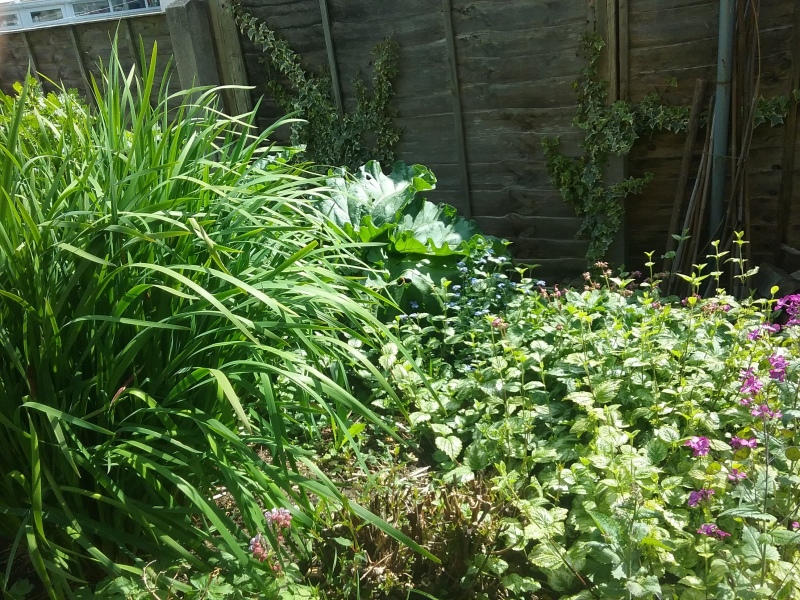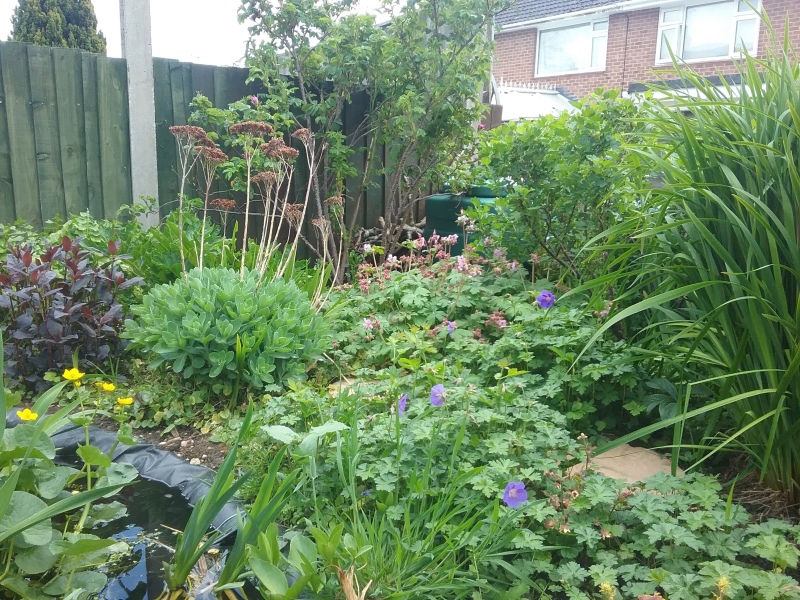Wildlife friendly gardening
May. 14th, 2021 03:52 pmThis is the first time I've tried DW's photo hosting (it's available to free users). It's a right pig's ear, but I've finally got it to work.
The trick seems to be to set the thumbnail size to around 1200 (or a bit smaller if you wish, but definitely not the default of 100), cut the thumbnail code and past it into the html version of your post.
Messy, but does actually work.
The garden is currently buzzing with bees (at least three different species, hoverflies, beeflies and other insects I can't identify. In the pond, there are tadpoles and newts, pond skaters, water boatmen, pond snails, water fleas and doubtless other things I've missed. I'm expecting dragonflies before long. We usually get them visiting and laying eggs.

,

There's fewer plants in the pond than normal as we had to replace the liner last winter because of a leek along a seam. But it will soon fill up again.
We grow quite a few edible plants in the garden.
One of my favourites is wild garlic. The have three great advantages in a garden. First off, they grow in dark, shady corners which are shunned by most plants, second you can eat the leaves, thirdly they make a gorgeous froth of little white starburst flowers in May.
You can see them here growing under our mulberry tree.

Mulberries have squishy, hard to pick fruits that stain the moment you touch them, but the flavour is wonderful and worth the effort!
In front of the garlic, you can see the purple flowers of honesty - another native plant. When the flowers have finished, leave the plant well alone, as the seed pods are wonderfully decorative and will stay there for many months and can be used indoors in flower arrangements, etc. Honesty is a biennial, so leave some seedlings to flower in a later year.
In the foreground, you can see a variegated leaf - that's lamium, (spotted deadnettle) which comes in many varieties, most of which are perfectly happy in the shade and many have pretty leaves and flowers.
Bees love all the plants I've mentioned so far.
Down the end of the garden, we have:

Rhubarb lurking behind the tall leaves of a lovely blue iris which will flower later on, and another variety of lamium. Rhubarb has big contrasting leaves, which can look good in a garden setting.

Next, two varieties of geraniums (blue and pink flowers), a second gooseberry bush (we like gooseberries a lot, and they make perfectly good shrubs), and tall Rosasrie de la Hey at the back by the compost bin.
I fell in love with Rosarie de la Hey when I hit the scent on walking into our local nursery a few years ago - they have an entire hedge of it. It has the best scent of any rose I've ever encountered and requires no pruning. The flowers are a single pink blossom, followed by wonderfully big red hips. I'm told the if you use it for a hedge, it's a good burglar deterrent - the thorns are very enthusiastic, but as I have it growing in a corner, it's not trouble at all. And I can smell the flowers whenever I walk along the back path.
The plant with last year's seed heads still visible (keep seed heads and old stalks as long as possible - insects need them over winter - and they add texture to a winter garden) is a sedum "Autumn Joy" which has pollinators flocking to it late in the season.
Pretty much everything we grow is bee friendly, with a preference for native plants.
It's not a particularly large garden, but we squeeze in two gooseberry bushes, a blackcurrant, a redcurrant, a tayberry growing through the hedge along one side (hedges are essential for small birds), a row of raspberries by the back door, plus wild garlic and rhubarb.
Plants that cope well with the shade are: wild garlic, lamium, epimedium (not a native, but I like the way the leaves appear to float and it's very good for shady, dry conditions), stinking iris - distinctive seed head with red berries, bluebells (try to get English not Spanish, and try to check if they have been grown legally), pulmonaria (an old cottage garden favourite - not in photo, as it's finished flowering. Mediterranean garlic will also grow there, but be warned, once you have it, you'll never get rid of it. It's very pretty, but it spreads very quickly. Red-veined sorrel can also tolerate shade and is edible. Ferns can cope fairly well with shade and there are several native species. We have harts tongue fern and others.